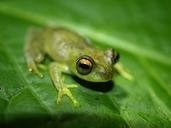|
Description
M 34-37 mm, F 48-52 mm. Dorsally green, typically with some light-green mottling and a thin white or yellowish dorsolateral line fading at midbody. Iris beige with brown. Iris periphery blue (Glaw and Vences 2007).
Distribution and Habitat
Country distribution from AmphibiaWeb's database: Madagascar
Ambolokopatrika corridor, Andapa, Ilampy, Marojejy, Masoala, Montagne d’Ambre, Tsaratanana (Antsahamanara campsite) (Glaw and Vences 2007). It occurs from 650-1,150 m asl, along streams in both pristine and degraded rainforest, plus secondary vegetation where trees are present (Glaw and Vences 2008).
Life History, Abundance, Activity, and Special Behaviors
Males call at night from perches 3-5 m high in the vegetation along streams in rainforest and in secondary vegetation. The call is very similar to that of B. luteus, and this species was therefore first considered a subspecies of B. luteus. However, as a major difference, the call of B. septentrionalis starts as a slow series of pulsed, unharmonious notes, and accelerates to contain more and more melodious whistling notes and a faster note repetition rate. The calls of B. septentrionalis are commonly heard at Montagne d’Ambre, but also around Andapa and in other areas of northern Madagascar with primary or secondary vegetation (Glaw and Vences 2007).
Trends and Threats
It occurs in two protected areas: the Parc National de Montagne d'Ambre and the Réserve Naturelle Intégrale du Tsaratanana. Although it can tolerate habitat disturbance, it is thought not likely to survive in completely open habitat. Threats include habitat loss due to increasing subsistence agriculture, logging, charcoal manufacture, invasion and spread of eucalyptus, increased grazing, and expanding human settlement (Glaw and Vences 2008). Possible reasons for amphibian decline General habitat alteration and loss
Habitat modification from deforestation, or logging related activities
Intensified agriculture or grazing
Urbanization
Subtle changes to necessary specialized habitat
Comments
Taken partly from Glaw and Vences (2007), with permission.
References
Glaw, F., and Vences, M. (2007). Field Guide to the Amphibians and Reptiles of Madagascar. Third Edition. Vences and Glaw Verlag, Köln.
Glaw, F., and Vences, M. (2008). Boophis septentrionalis. In: IUCN 2008. 2008 IUCN Red List of Threatened Species. www.iucnredlist.org. Downloaded on 23 March 2009.
Originally submitted by: Miguel Vences and Frank Glaw (first posted 2009-03-17)
Edited by: Kellie Whittaker (2009-03-23)Species Account Citation: AmphibiaWeb 2009 Boophis septentrionalis <https://amphibiaweb.org/species/6770> University of California, Berkeley, CA, USA. Accessed Nov 22, 2024.
Feedback or comments about this page.
Citation: AmphibiaWeb. 2024. <https://amphibiaweb.org> University of California, Berkeley, CA, USA. Accessed 22 Nov 2024.
AmphibiaWeb's policy on data use.
|





 Map of Life
Map of Life